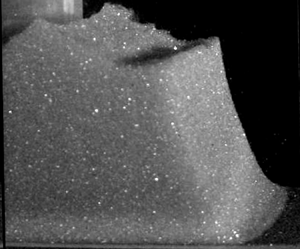Crossref Citations
This article has been cited by the following publications. This list is generated based on data provided by
Crossref.
Hoggarth, Johnathan
Ono-dit-biot, Jean-Christophe
and
Dalnoki-Veress, Kari
2023.
Two-dimensional spreading of frictionless adhesive oil droplets.
Soft Matter,
Vol. 19,
Issue. 20,
p.
3747.
Staron, Lydie
Duchemin, Laurent
and
Lagrée, Pierre-Yves
2023.
Cohesive granular columns collapsing: Numerics questioning failure, cohesion, and friction.
Journal of Rheology,
Vol. 67,
Issue. 5,
p.
1061.
Wu, Yisong
Sun, Yinghao
and
Wang, Dengming
2023.
The combined effect of cohesion and finite size on the collapse of wet granular columns.
Soft Matter,
Vol. 19,
Issue. 48,
p.
9520.
Chatre, Lucas
Lemerle, Xavier
Bataille, Marc
Debacq, Marie
Randriamanantena, Tojonirina
Lamadie, Fabrice
Nos, Jeremy
and
Herbelet, Florian
2024.
Experimental study of the wall particle motion in a screw reactor.
Powder Technology,
Vol. 448,
Issue. ,
p.
120181.
Blatny, L.
Gray, J.M.N.T.
and
Gaume, J.
2024.
A critical stateμ(I)-rheology model for cohesive granular flows.
Journal of Fluid Mechanics,
Vol. 997,
Issue. ,
Gans, Adrien
Dalloz-Dubrujeaud, Blanche
Nicolas, Maxime
and
Aussillous, Pascale
2024.
Discharge Flow of a Cohesive Granular Media from a Silo.
Physical Review Letters,
Vol. 133,
Issue. 23,
Bhat K. I., Manasa
Hurley, Ryan C.
and
Murthy, Tejas G.
2024.
Micromechanics of contact-bound cohesive granular materials in confined compression.
Physical Review E,
Vol. 109,
Issue. 5,
Chatre, Lucas
Lemerle, Xavier
Bataille, Marc
Herbelet, Florian
Debacq, Marie
Nos, Jeremy
Saleh, Khashayar
Leturia, Mikel
and
Randriamanantena, Tojonirina
2024.
Numerical study of dense powder flow in a rotating drum: Comparison of CFD to experimental measurements.
Powder Technology,
Vol. 444,
Issue. ,
p.
119981.
Karuriya, Ashta Navdeep
Simoes, Jeremy
and
Barthelat, Francois
2024.
Fully dense and cohesive FCC granular crystals.
Extreme Mechanics Letters,
Vol. 71,
Issue. ,
p.
102208.
Rousseau, Hugo
Gaume, Johan
Blatny, Lars
and
Lüthi, Martin P.
2024.
Transition Between Mechanical and Geometric Controls in Glacier Crevassing Processes.
Geophysical Research Letters,
Vol. 51,
Issue. 9,
Zhu, Rui
He, Zhiguo
and
Meiburg, Eckart
2024.
Effects of initial packing density and cohesion on submerged granular collapse.
Physical Review Fluids,
Vol. 9,
Issue. 8,
Sharma, Ram Sudhir
Sarlin, Wladimir
Xing, Langqi
Morize, Cyprien
Gondret, Philippe
and
Sauret, Alban
2024.
Effects of interparticle cohesion on the collapse of granular columns.
Physical Review Fluids,
Vol. 9,
Issue. 7,
Inoue, Ryusuke
and
Otsuki, Michio
2025.
Collapse of Wet Granular Column under Gravity.
Journal of the Society of Powder Technology, Japan,
Vol. 62,
Issue. 10,
p.
556.
Zhang, Shuai
Xu, Jiayu
Syed, Abul Hassan
Hua, Leina
Wu, Chuan-Yu
Lian, Guoping
and
Ge, Wei
2025.
Numerical and experimental investigation of the effect of interstitial liquid viscosity on the collapse of wet granular columns.
Chemical Engineering Science,
Vol. 301,
Issue. ,
p.
120725.
Fransen, Marc
Fürst, Andreas
Tunuguntla, Deepak
Wilke, Daniel N.
Alkin, Benedikt
Barreto, Daniel
Brandstetter, Johannes
Cabrera, Miguel Angel
Fan, Xinyan
Guo, Mengwu
Kieskamp, Bram
Kumar, Krishna
Morrissey, John
Nuttall, Jonathan
Ooi, Jin
Orozco, Luisa
Papanicolopulos, Stefanos-Aldo
Qu, Tongming
Schott, Dingena
Shuku, Takayuki
Sun, WaiChing
Weinhart, Thomas
Ye, Dongwei
and
Cheng, Hongyang
2025.
Towards Scientific Machine Learning for Granular Material Simulations: Challenges and Opportunities.
Archives of Computational Methods in Engineering,
Pouliquen, Olivier
2025.
Powders and cohesive granular media: a rheological perspective.
Rheologica Acta,
Vol. 64,
Issue. 4-5,
p.
195.
Zhang, Xiaopeng
Hu, Kaiheng
Li, Hao
Liu, Shuang
and
Wei, Li
2025.
Investigation on collapse dynamics of ice-sand bi-frictional mixtures using material point method.
Physics of Fluids,
Vol. 37,
Issue. 9,
Tang, Xiong
He, Siming
Liu, Wei
Jaboyedoff, Michel
Zhu, Lei
Zhang, HuanHuan
Wang, Di
and
Huo, Zenan
2025.
Dry granular column collapse by elastic-viscoplastic constitutive model of dense granular flow.
Physics of Fluids,
Vol. 37,
Issue. 8,
Sharma, Ram Sudhir
and
Sauret, Alban
2025.
Experimental models for cohesive granular materials: a review.
Soft Matter,
Vol. 21,
Issue. 12,
p.
2193.
Ma, Fanshuo
Lagrée, Pierre-Yves
and
Staron, Lydie
2025.
Exploring the gravity-driven failure of a cohesive granular column.
Physical Review E,
Vol. 111,
Issue. 5,



